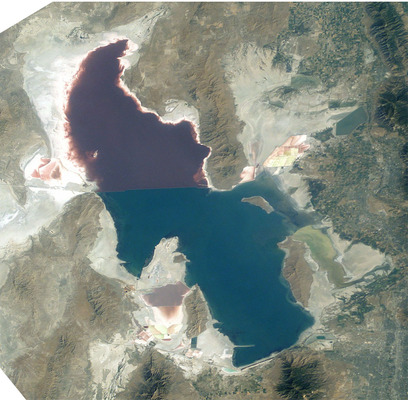
by Brian Fisher Johnson Thursday, January 5, 2012

Utah's Great Salt Lake, as seen from the International Space Station in August 2003. The north and south sections of the lake are separated by a railway and have different salt concentrations. NASA Earth Observatory
SAN FRANCISCO — Colorado skiers have long suspected that snowfall is fluffiest when winds blow salt and dust eastward from the Great Salt Lake in Utah. Now that wisdom is confirmed by science.
After measuring cloud particles from plane flights over Colorado, atmospheric chemist Kim Prather of Scripps Institution of Oceanography in La Jolla and colleagues determined that nascent snow largely formed as a result of suspended Utah salt.
In order for snow and rain droplets to form, water needs a particle base on which to accumulate. This process is called nucleation.
Prather and colleagues were then able to link the physical characteristics of the cloud salt with salt surrounding the Great Salt Lake. “It’s like nature has figured out the perfect cloud seed,” Prather says.
While salts are normally associated with melting snow, the high solubility of some Utah salts helps them rise with water as it evaporates, explaining the amount of suspended salt over Colorado. Salt-nucleated snow is also more watery.
Prather says such studies show the importance of ground particles in cloud formation and precipitation patterns. The water vapor that forms clouds helps shade Earth from sunlight. Too many suspended particles, however, can thin out water vapor accumulation so that no one particle has enough water to fall as rain or snow, leading to drought.
The results were presented this week at the annual conference of the American Geophysical Union.
© 2008-2021. All rights reserved. Any copying, redistribution or retransmission of any of the contents of this service without the expressed written permission of the American Geosciences Institute is expressly prohibited. Click here for all copyright requests.